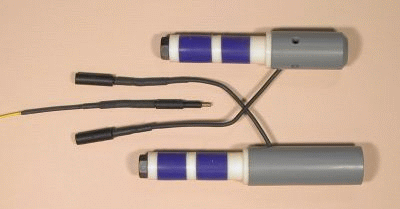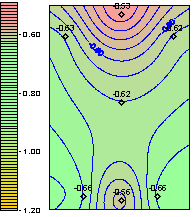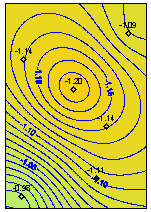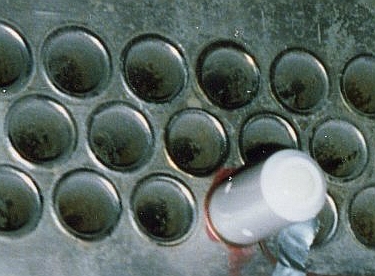Tubesheet Mounted Reference Electrode
The potential across a tubesheet under cathodic protection can show large variations from one location to another. Different waterboxes of the same apparent design can produce different potential distributions. Areas with excessively electronegative potentials can cause hydrogen damage to titanium or ferritic stainless steel tubes. Other areas may have potentials insufficiently negative to adequately protect the copper alloy tubesheet. These potential gradients cannot be detected by a reference electrode mounted on the side wall of the waterbox.

The Model TE Tubesheet Mounted Reference Electrode is designed to mount any place on the face of a tubesheet. They are shipped with a double tube plug which is inserted into the end of a condenser tube and tightened. Tube plugs are available for common tube sizes between 5/8 inch and 1-1/4 inch. The electrode’s lead wire terminates in a waterproof connector which plugs into a mating connector on the Model TW wire which has been affixed to the tube sheet face. This attachment system allows the electrode to be easily removed during scheduled outages.



Element Selection Guide
EDI reference electrodes may be ordered with any of five different reference elements. The element selected depends upon the electrolyte in which the electrode is used.
Gelled copper/copper sulfate elements (EDI code CUG) are typically used in environments with less than 500 ppm chloride or other halides. They consist of high purity metallic copper immersed in a saturated CuSO4 solution containing a gelling agent. Use of these elements in electrolytes with higher halide levels or in electrolytes with any sulfides present will contaminate the element causing its reference potential to drift. Because of their widespread use, Cu/CuSO4 electrodes are the ones upon which many cathodic protection criteria are based. Cu/CuSO4 elements are available in all EDI product groups except Concrete Products.
Gelled silver/silver chloride elements (EDI code AGG) can be used in any environment which does not contain sulfides. They consist of 99.99% pure silver coated with silver chloride and immersed in a saturated potassium chloride solution containing a gelling agent. The reference potential of Ag/AgCl/sat. KCl elements is 105 mV negative to that of a saturated Cu/CuSO4 reference electrode. Ag/AgCl/sat. KCl elements are available in all EDI product groups.
Dry silver/silver chloride elements (EDI code AGD) are most commonly used in clean full strength seawater where the electrolyte comes into direct contact with the element. Like the gelled Ag/AgCl elements, they are adversely affected by sulfides. The reference potential of dry Ag/AgCl elements immersed in full strength seawater is 70 mV negative to that of a saturated Cu/CuSO4 reference electrode. As the ambient chloride level decreases, as would be the case when used in brackish water, the reference potential becomes less positive. Dry Ag/AgCl elements are only available in our through-wall, immersion and tubesheet mounted reference electrodes.
Dry silver/silver chloride elements for concrete (EDI code AGC) is a variation of our standard dry Ag/AgCl element which has been adapted for encasement in a cement-based grout. The reference potential depends on the pore water chloride level of the concrete structure in which it is embedded. This element is only available in our Marine Concrete reference electrode, EDI Model CM-AGC.
Zinc elements (EDI code ZIN) consist of high purity metallic zinc rod. When these elements are used in our underground reference electrodes, the zinc element is encased in a gypsum-bentonite backfill. The zinc element is directly wetted by the electrolyte in our through-wall and immersion reference groups. Reference potential of a zinc element encapsulated in backfill is about 1,100 mV negative to that of a saturated Cu/CuSO4 reference electrode. The reference potential of zinc directly exposed to an electrolyte depends on the composition of the electrolyte.
For More Information
Complete Product Information is available for downloading as pdf files. Click on the link below to download.
Tubesheet Mounted Reference Electrode (Models TE and TW) data sheet.
EDI products may be purchased from any corrosion control products distributor or directly from EDI.
